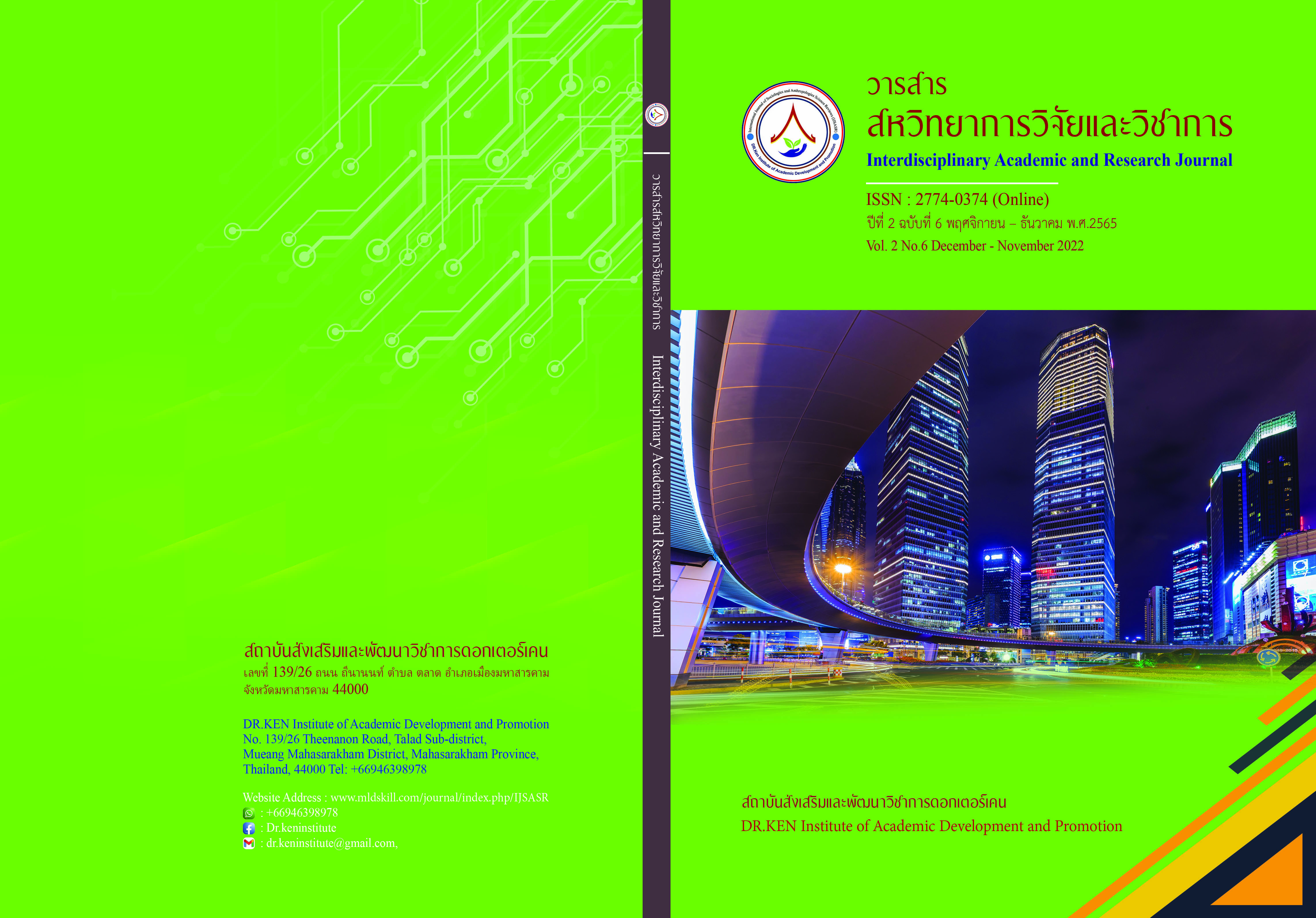The Impact of Digital Marketing on the Marketing Performance of Local Identity Farmers in Maha Sarakham Province
DOI:
https://doi.org/10.14456/iarj.2022.165Keywords:
Digital Marketing; , Marketing Performance;, FarmersAbstract
Digital transformation has played a role in society, economy, and environment that has changed the paradigm of living and operations of the organization including agriculture as the main occupation in many countries. It is necessary to learn the innovations that occur to apply them for the greatest benefit of people, society, and the economy. The purposes of this research were: 1) to study the importance of digital marketing of local identity farmers. 2) to study the level of marketing performance of local identity farmers., and 3) to study the influence of the importance of digital marketing on the marketing performance of local identity farmers. Collecting data from 400 farmers in Maha Sarakham Province and a set of questionnaires were the research tool. Statistics used for data analysis were mean, standard deviation, multiple correlation analysis, and stepwise multiple regression analysis. The results revealed the following findings; 1) farmers had opinions about digital marketing in general aspect at a high level and had an average of 4.17, the averages are arranged in descending order as follows: social media marketing aspect had an average of 4.22, content marketing aspect had an average of 4.18, Value Chain aspect had an average of 4.10., 2) farmers had opinions about marketing performance in general aspect at a high level and had an average of 4.16, the averages are arranged in descending order as follows: customer retention aspect had an average of 4.25, sales growth aspect had an average of 4.18, market share aspect had an average of 4.16, profitability aspect had an average of 4.05., and 3) digital marketing had positive relationship and impact on marketing performance of local identity farmers and the forecast in standard score (b) form of 0.498, 0.163, and 0.143, and has a multiple correlation coefficient (R) of 0.633, a forecasting power (R2) of 0.401, and a forecasting power of 40.10%.
References
กระทรวงเกษตรและสหกรณ์. (2564). ระบบสารสนเทศการผลิตทางด้านการเกษตร. [Online] : https://production.doae.go.th. [15 ธันวาคม 2564]
คณะกรรมาธิการการเกษตรและสหกรณ์. (2564). ผลกระทบต่อระบบเศรษฐกิจไทยจากโรคติดต่อเชื้อโคโรนาไวรัส (COVID-19) และข้อเสนอแนะเพื่อขับเคลื่อนการพัฒนาภาคเกษตรภายใต้แผนยุทธศาสตร์ชาติตามสถานการณ์. กรุงเทพฯ: สำนักงานเลขาธิการวุฒิสภา.
ชาตรี บัวคลี่. (2561). การพัฒนาอัตลักษณ์องค์กรสมาร์ตฟาร์มเมอร์ (Smart Farmer) ด้วยวิธีบูรณาการการวิจัย การบริการวิชาการและการเรียนการสอนอย่างมีส่วนร่วมตามแนวคิดเศรษฐกิจดิจิทัล. Veridian E-Journal, Silpakorn University. 11(2), 1912-1929.
ญาณิศา ยอดสิน กนกวรรณ ศรมณี และ โชติ บดีรัฐ. (2564). วิกฤติโควิด-19 การเปลี่ยนแปลงภาคการเกษตรไทยสู่วิถีชีวิตใหม่ (New Normal). Journal of Roi Kaensarn Academi. 6(12), 318-328.
นันทินา ดำรงวัฒนกูล พรชนก ทองลาด ศิรญา จนาศักดิ์ จำเนียร มีสำลี ปิยะรัตน์ ทองธานี จักรชัยวัฒน์ กาวีวงศ์ กรรณิการ์ สายเทพ และกาญจนา รัตนธีรวิเชียร. (2564). กระบวนการพัฒนาข้าวอัตลักษณ์ลําปางโดยการสร้างเสริมพลังการเรียนรู้เกษตรกร (ชาวนาอัจฉริยะ) ผ่านการวิจัยเชิงปฏิบัติการแบบมีส่วนร่วม. วารสารปัญญาภิวัฒน์. 13(3), 255-269.
บุญชม ศรีสะอาด. (2560). การวิจัยเบื้องต้น. พิมพ์ครั้งที่ 10. กรุงเทพฯ : สุวีริยาสาส์น.
สำนักงานจังหวัดมหาสารคาม. (2564). แผนพัฒนาจังหวัดมหาสารคาม พ.ศ. 2566-2570. มหาสารคาม : สำนักงานจังหวัดมหาสารคาม.
Aksoy, H. (2017). How do innovation culture, marketing innovation, and product innovation affect the market performance of small and medium-sized enterprises (SMEs)? Technology in Society. 51, 133-141.
Amjad, T. (2022). Digital entrepreneurial marketing: A bibliometric analysis reveals an inescapable need of business schools. The International Journal of Management Education. 20(2022) 100655, 1-8.
Black, K. (2006). Business statistics for contemporary decision making. 4thedition. New York: John Wiley and Sons.
Klerkx, L., Jakku, E., & Labarthe, P. (2019). A review of social science on digital agriculture, smart farming and agriculture 4.0: New contributions and a future research agenda. NJAS - Wageningen Journal of Life Sciences. 90–91 (2019) 100315, 1-16.
Krejcie, R. V., & Morgan, D. W. (1970). Determining Sample Size for Research Activities. Educational and Psychological Measurement. 30, 607-610.
Li, H., & O’Connor, A. (2017). The entrepreneurial influence on winery market Performance a mediation perspective. International Journal of Wine Business Research, 29(2), 210-232.
Phillips, W.B., P., Relf-Eckstein, J.A., & Brian Wixted, G. A. (2019). Configuring the new digital landscape in western Canadian agriculture. NJAS - Wageningen Journal of Life Sciences. 90-91 (2019) 100295, 1-11.
Rizvanovi´c B., Zutshi, A., Grilo, A., & Nodehi, T. (2022). Linking the potentials of extended digital marketing impact and start-up growth: Developing a macro-dynamic framework of start-up growth drivers supported by digital marketing. Technological Forecasting & Social Change. 186 (2023) 122128, 1-24.
Smith, M.J. (2018). Getting value from artificial intelligence in agriculture. Animal Production Science. 60(1), 46-54.
Terho, H., Mero, J. Siutla, L., & Jaakkola, E. (2022). Digital content marketing in business markets: Activities, consequences, and contingencies along the customer journey. Industrial Marketing Management. 105 (2022), 294–310.
Theodore, F.L., Lopez-Santiago M., Cruz-Casarrubias, C., Mendoza-Pablo P.A., Barquera S., & Tolentino-Mayo, L. (2021). Digital marketing of products with poor nutritional quality: a major threat for children and adolescents. Public Health. 198 (2021), 263-269.
Downloads
Published
How to Cite
Issue
Section
License
Copyright (c) 2022 Nava Masaunjik, Piyawan Yangkham, Thirasak Kiangkhwa, Kotchanipa Wanichkittikul, Amorn Thotham

This work is licensed under a Creative Commons Attribution-NonCommercial-NoDerivatives 4.0 International License.
Copyright on any article in the Interdisciplinary Academic and Research Journal is retained by the author(s) under the under the Creative Commons Attribution-NonCommercial-NoDerivatives 4.0 International License. Permission to use text, content, images, etc. of publication. Any user to read, download, copy, distribute, print, search, or link to the full texts of articles, crawl them for indexing, pass them as data to software, or use them for any other lawful purpose. But do not use it for commercial use or with the intent to benefit any business.
















.png)


